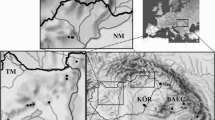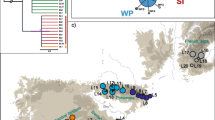Abstract
In conservation genetics the existence of Evolutionarily Significant Units (ESU) is a crucial question in threatened or vulnerable species. It is of particular concern to determine whether different subspecies or ecotypes of a species can be considered as separate ESUs. Some Melitaea subg. Mellicta species (e.g. Mellicta aurelia, Mellicta britomartis) are declining or scarce in Europe. Therefore, the level of genetic differentiation and pattern of genetic variation were surveyed in three Melitaea (subg. Mellicta) species. Their habitat requirements and food plants partly overlap; accordingly they often co-occur in the same habitat. M. britomartis and M. aurelia have one brood per year in Hungary, while Mellicta athalia has a monovoltine and a bivoltine ecotype. The purpose of the study was to estimate the number of genetically differentiated ESUs among these species in the Carpathian basin. Samples were taken from 5 Hungarian regions and a few samples were collected in Transylvania as well. Enzyme polymorphism was studied using polyacrylamide gel electrophoresis. The structure of genetic variation was analysed by F-statistics, AMOVA, PCA and Bayesian clustering method. UPGMA dendrogram was constructed on the basis of Cavalli-Sforza and Edwards chord distances. The three species are clearly differentiated from each other in all statistical analyses. They are evidently different Evolutionary Significant Units. The two ecotypes of M. athalia, however, do not show any genetic differentiation.






Similar content being viewed by others
References
Achtelik G (2006) Molekularbiologische Analyse der genetischen Diversität des Melitaea athalia/celadussa-Komplexes (Lepidoptera: Nymphalidae) unter Anwendung der ISSR-PCR auf Art-, Unterart- und Populationsebene. Ruhr-Universität Bochum
Allendorf FW, Luikart G (2007) Conservation and the genetics of populations. Blackwell, Oxford
Antunes A, Faria R, Weiss S, Alexandrino P (2001) Complex evolutionary history in the brown trout: insights on the recognition of conservation units. Conserv Genet 2:337–347
Avise JC (2005) Phylogenetic units and currencies above and below the species level. In: Purvis A, Gittleman JL, Brooks T (eds) Phylogeny and conservation. Cambridge University Press, Cambridge, pp 77–100
Bereczki J, Pecsenye K, Peregovics L, Varga Z (2005) Pattern of genetic differentiation in the Maculinea alcon species group (Lepidoptera, Lycaenidae) in Central Europe. J Zool Syst Evol Res 43:157–165
Cavalli-Sforza LL, Edwards AWF (1967) Phylogenetic analysis: models and estimation procedures. Am J Hum Genet 19:233–257
Crandall KA, Bininda-Emonds ORP, Mace GM, Wayne RK (2000) Considering evolutionary processes in conservation biology. Tree 15
Ebert G, Renwald E (1991) Die Schmetterlinge Baden-Württenbergs. Eugen Ulmer GmbH, Stuttgart
Excoffier L, Smouse P, Quattro J (1992) Analysis of molecular variance inferred from metric distances among DNA haplotypes: application to human mitochondrial DNA restriction data. Genetics 131:479–491
Felsenstein J (1985) Confidence limits on phylogenies: an approach using the bootstrap. Evolution 39:783–791
Goudet J (1995) Fstat version 1.2: a computer program to calculate F-statistics. J Hered 86:485
Hammer Ø, Harper DAT, Ryan PD (2006) PAST—paleontological statistics, version 1.56 Web site http://folk.uio.no/ohammer/past
Hammouti N, Schmitt T, Seitz A, Kosuch J, Veith M (2010) Combining mitochondrial and nuclear evidences: a refined evolutionary history of Erebia medusa (Lepidoptera: Nymphalidae: Satyrinae) in Central Europe based on the COI gene. J Zool Syst Evol Res 48:115–125
Hobbs RJ, Mooney HA (1998) Broadening the extinction debate: population deletions and additions in California and Western Australia. Conserv Biol 12:271–283
Hodgson JA, Moilanen A, Bourn NAD, Bulman CR, Thomas CD (2009) Managing successional species: modelling the dependence of heath fritillary populations on the spatial distribution of woodland management. Biol Conserv 142:2743–2751
Hughes JB, Daily GC, Ehrlich PR (1997) Population diversity: its extent and extinction. Science 278:689–692
Leneveu J, Chichvarkhin A, Wahlberg N (2009) Varying rates of diversification in the genus Melitaea (Lepidoptera: Nymphalidae) during the past 20 million years. Biol J Linn Soc 97:346–361
Lozier JD, Roderick GK, Mills NJ (2008) Evolutionarily significant units in natural enemies: identifying regional populations of Aphidius transcaspicus (Hymenoptera: Braconidae) for use in biological control of mealy plum aphid. Biol Control 46:532–541
Maes D, Vanreusel W, Talloen W, Van Dyck H (2004) Functional conservation units for the endangered Alcon Blue butterfly Maculinea alcon in Belgium (Lepidoptera : Lycaenidae). Biol Conserv 120:229–241
Moritz C (1994) Defining evolutionarily-significant-units for conservation. Trends Ecol Evol 9:373–375
Paplinska JZ, Taggart DA, Corrigan T, Eldridge MDB, Austin JJ (2011) Using DNA from museum specimens to preserve the integrity of evolutionarily significant unit boundaries in threatened species. Biol Conserv 144:290–297
Peacock MM, Robinson ML, Walters T, Mathewson HA, Perkins R (2010) The evolutionarily significant unit concept and the role of translocated populations in preserving the genetic legacy of Lahontan cutthroat trout. Trans Am Fish Soc 139:382–395
Pritchard JK, Stephens M, Donelly P (2000) Inference of population structure using multilocus genotype data. Genetics 155:945–959
Raymond M, Rousset F (1995a) An exact test for population differentation. Evolution 49:1280–1283
Raymond M, Rousset F (1995b) GENEPOP ver.1.2, a population genetics software for exact tests and ecumenicism. J Hered 86:246–249
Ryder OA (1986) Species conservation and systematics: the dilemma of subspecies. Trends Ecol Evol 1:9–10
Schadewald G (1988) Anmerkungen zu Melitaea neglecta PFAU, 1962 (Lep., Nymphalidae). Nachr Entomol Ver Apollo 8:109–112
Schmitt T, Rakosy L, Abadjiev S, Muller P (2007) Multiple differentiation centres of a non-Mediterranean butterfly species in south-eastern Europe. J Biogeogr 34:939–950
Schneider S, Roessli D, Excoffier L (2000) Arlequin ver. 2.000: a software for population genetic data analysis. Genetics and Biometry Laboratory, University of Geneva, Switzerland
Settele J, Feldmann R, Reinhardt R (1999) Die Tagfalter Deutschland. Verlag Eugen Ulmer, Stuttgart
Sneath PH, Sokal RR (1962) Numerical taxonomy. Nature 193:855–860
Stefanni S, Thorley JL (2003) Mitochondrial DNA phylogeography reveals the existence of an Evolutionarily Significant Unit of the sand goby Pomatoschistus minutus in the Adriatic (Eastern Mediterranean). Mol Phylogenet Evol 28:601–609
Tolman T, Lewington R (1998) Die Tagfalter Europas und Nordwestafrikas. Franck-Kosmos-Verlags-GmbH and Co, Stuttgart
Urbahn E (1952) Unterschiede der Jugendstände von M. athalia und M. parthenie in Deutschland. Zeitschr d Wr Ent Ges 37:105–121
Van Swaay C, Warren M (1999) Red data book of European butterflies (Rhopalocera). Council of Europe Publishing, Strasbourg
Van Swaay C, Cuttelod A, Collins S, Maes D, Munguira ML, Sasic M, Settele J, Verovnik R, Verstrael T, Warren M, Wiemers M, Wynhoff I (2010) European red list of butterflies. Publications Office of the European Union, Luxembourg
Vila M, Lundhagen AC, Thuman KA, Stone JR, Bjorklund M (2006) A new conservation unit in the butterfly Erebia triaria (Nymphalidae) as revealed by nuclear and mitochondrial markers. Ann Zool Fenn 43:72–79
Wahlberg N (1998) The life history and ecology of Euphydryas maturna (Nymphalidae: Melitaeini) in Finland. Nota Lepid 21:154–169
Wahlberg N (2000) Comparative descriptions of the immature stages and ecology of five Finnish melitaeine butterfly species (Lepidoptera : Nymphalidae). Entomol Fennica 11:167–174
Wahlberg N (2001) The phylogenetics and biochemistry of host-plant specialization in Melitaeine butterflies (Lepidoptera : Nymphalidae). Evolution 55:522–537
Wahlberg N, Zimmermann M (2000) Pattern of phylogenetic relationships among members of the tribe Melitaeini (Lepidoptera : Nymphalidae) inferred from mitochondrial DNA sequences. Cladistics 16:347–363
Waples RS (1991) Pacific salmon, Oncorbynchus spp., and the definition of “species” under the Endangered Species Act. Marine Fisheries. Mar Fish Rev 53:11–22
Warren MS (1987a) The ecology and conservation of the heath fritillary butterfly, Mellicta athalia. I. Host selection and phenology. J Appl Ecol 24:467–482
Warren MS (1987b) The ecology and conservation of the heath fritillary butterfly, Mellicta athalia. II. Adult population structure and mobility. J Appl Ecol 24:483–498
Warren MS (1987c) The ecology and conservation of the heath fritillary butterfly, Mellicta athalia. III. Population dynamics and the effect of habitat management. J Appl Ecol 24:499–513
Weidemann H-J (1988) Tagfalter: Biologie, Okologie, Biotopschutz. Verlag J. Neumann-Neudamm GmbH and Co. KG, Melsungen, Germany
Weir BS (1996) Data analysis II: methods for discrete population genetic Data. Sinauer Associates Inc, Sunderland
Wright S (1978) Evolution and the genetics of populations. University of Chicago Press, Chicago
Zink RM (2004) The role of subspecies in obscuring avian biological diversity and misleading conservation policy. P Roy Soc Lond B Bio 271:561–564
Acknowledgments
The study was supported by the NKFP-3 B/023/2004 and OTKA 84071 K projects. The authors are grateful to P. Kozma and S. Szabó who effectively contributed to the sampling. The technical assistance of V. Mester in the electrophoretic work is very much respected. Suggestions of the unknown reviewers improved the manuscript to a great extent. The support of the Nature Conservation Authorities of Hungary is highly appreciated.
Author information
Authors and Affiliations
Corresponding author
Rights and permissions
About this article
Cite this article
Bátori, E., Pecsenye, K., Bereczki, J. et al. Patterns of genetic and taxonomic differentiation in three Melitaea (subg. Mellicta) species (Lepidoptera, Nymphalidae, Nymphalinae). J Insect Conserv 16, 647–656 (2012). https://doi.org/10.1007/s10841-011-9447-y
Received:
Accepted:
Published:
Issue Date:
DOI: https://doi.org/10.1007/s10841-011-9447-y




